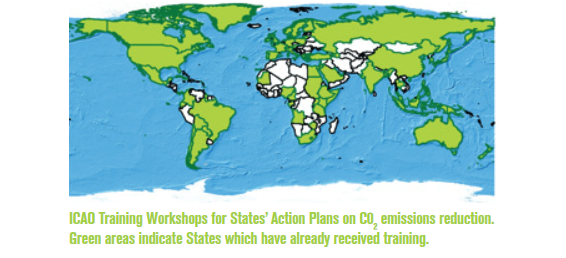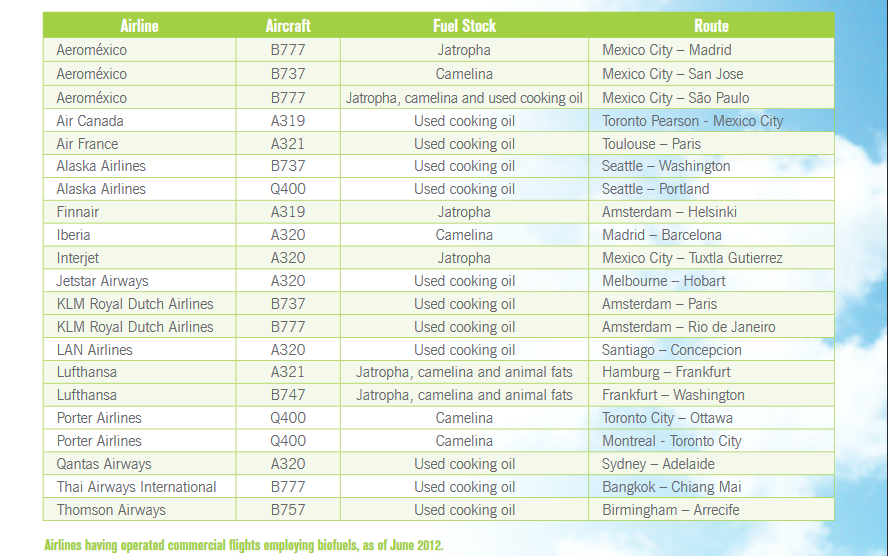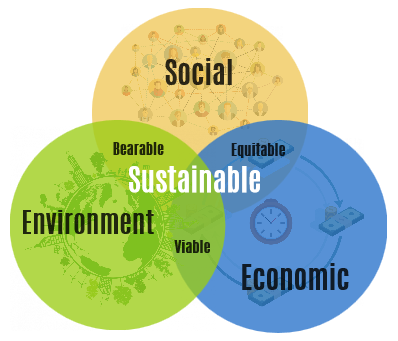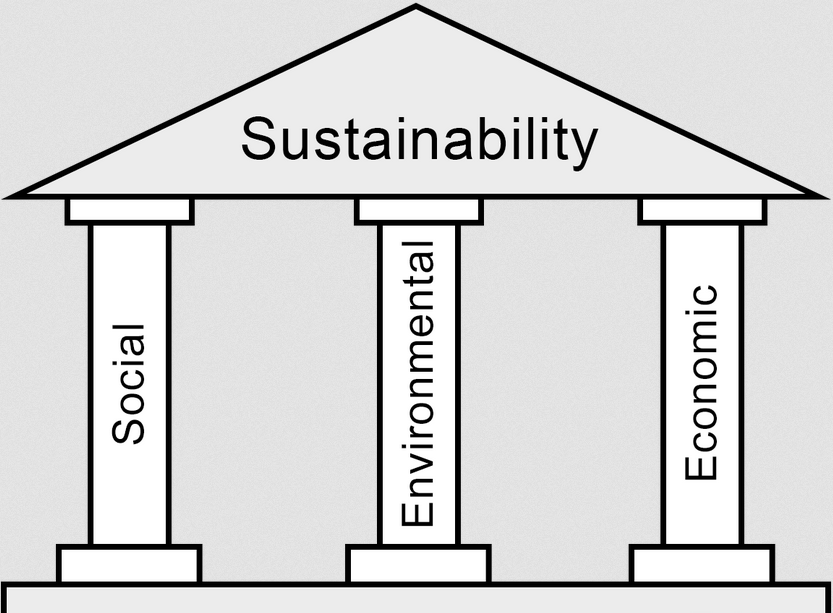The objective of this post is to gather and put in one place all the important concepts, tips, tools and best practices for sustainability in aviation found all over the internet. Outcomes of the research:
- Relate the three pillars of sustainability to aviation and aerospace organizations
- Explain the benefits of sustainable principles to aviation and aerospace entities
- Examine environmental actions associated with sustainable aviation and aerospace companies
- Identify the role of social responsibility in aviation and aerospace industries
- Analyze initiatives that contribute to economic sustainability in aviation and aerospace organizations.
- Assess organizational strategies to promote sustainable practices
- Select the best practices associated with sustainable aviation and aerospace organizations
Defining Sustainable Foundations For Aviation/Aerospace Organizations
When we hear the word sustainable, we may immediately think of the environment or associate the word with the concept of being “green.” While the environment is a very important area of sustainability, it is only one part of creating or building a sustainable enterprise. So to fully understand the long term goals, we must think beyond green to grasp the potential outcomes related to sustainability. To better appreciate the relationship between sustainability to the aviation and aerospace industry, we need to establish the basic foundations of sustainability.
Let’s start by picturing sustainability as the intersection of the three concepts like the one pictured. Note the labels on the circles of environmental, social, and economic. True sustainability is achieved by finding the intersection of all three areas. Keep this image in mind as we continue on our journey in learning how the individual sectors create sustainable goals for the future of aviation and aerospace organizations.
“Another popular and very powerful tool for defining the complete sustainability problem, the “three pillars of sustainability” is shown below. This consists of at least the economic, social, and environmental pillars. If any one pillar is weak then the system as a whole is unsustainable.
Why this is important: Most national and international problem solving efforts focus on only one pillar at a time. For example, the United Nations Environmental Programme (UNEP), the environmental protection agencies (EPA) of many nations, and environmental NGOs focus on the environmental pillar. The World Trade Organization (WTO) and the Organization for Economic Cooperation and Development (OECD) focus mostly on economic growth, thought the OECD gives some attention to social sustainability, like war reduction and justice. The United Nations attempts to strengthen all three pillars, but due to its consensual decision making process and small budget has minor impact. The United Nations focuses mostly on the economic pillar, since economic growth is what most of its members want most, especially developing nations.
This leaves a void. No powerful international organization is working on the sustainability problem as a whole, which would include all three pillars.
However, as the Great Recession of 2008 demonstrated, weakness in the other pillars can directly weaken the environmental pillar.
Many nations and states are cutting back or postponing stricter environmental laws or investment, since their budgets are running deficits. Many environmental NGOs are seeing their income fall. If the Great Recession grew substantially worse and morphed into another Great Depression, you would expect the environmental pillar would get severely less attention, since eating now is a priority over saving the environment.
The social pillar is critical too. Once a war breaks out environmental sustainability has zero priority. If a nation lives in dire poverty, the environment is pillaged with little thought for the future.
Therefore solutions to the sustainability problem must include making all three pillars sustainable.”
Read more: thwink.org
For many authors, sustainability represents a goal - the capacity for continuance into the long-term future. Sustainable development on the other hand consists of the process (and priorities) of moving toward this ideal end-state.
"The concept of sustainable development was first articulated by the World Conservation Strategy of the International Union for Conservation of Nature and Natural Resources (IUCN 1980). Since then, the concept has evolved from series of international meetings beginning with the United Nations World Commission on Environment and Development (WCED), also known as the Brundtland Commission (WCED 1987a).
"The concept of sustainable development was first articulated by the World Conservation Strategy of the International Union for Conservation of Nature and Natural Resources (IUCN 1980). Since then, the concept has evolved from series of international meetings beginning with the United Nations World Commission on Environment and Development (WCED), also known as the Brundtland Commission (WCED 1987a).
Note the definition of sustainable development in the verbiage from the United Nations World Commission of Environment and Development (WCED):
“sustainable development is improving people’s life-enabling habits to meet our needs in the present without compromising the ability of future generations to meet their needs”
(WCED 1987b). The definition is much debated, but it is a starting point or basis of understanding. The author also notes that we must not focus on environmental concerns alone.
“It is important however, to distinguish here between the meaning of truths and what we will discuss later, principles. The statement of a truth represents a reality in our world, a fact that is supported by scientific evidence, as we know it to be now, whether it is natural, social, or economic science. A principle, on the other hand, represents a belief that forms the foundation of a fundamental doctrine (like sustainability) or serves as a rule, law, or assumption about the nature of a policy.
These truths include the following:
- Everything material on Earth has limitations.
- Many components of our global system are interconnected.
- Change is the norm, not the exception.
- All socioeconomic factors are grounded in a healthy environment.
- Diversity within systems (natural or human) will contribute to the system’s
stability and resiliency (includes ecologic, economic, and sociocultural diversity). - Equity is the foundation of healthy functioning systems.
- Uncertainty and ignorance are often associated with complex systems.”

Let’s take a look at the 17 Sustainable Development Goals (SDGs) created by the United Nations (UN) in 2015. As you read through the goals you may think that the aviation and aerospace industries have little to do with such goals as eradicating poverty, health or equality for example. But the truth is collectively aviation and aerospace can be an integral part of realizing any or all of the goals.

Stop poverty around the world. Poverty doesn't just mean being poor, it can mean not having other things you need to live a good life.

Stop people going hungry, make sure everyone can get the good, healthy food they need and use ways of growing food that will work into the future.

Make sure people are healthy and making healthy decisions all through their lives.

Make sure everybody has equal opportunities and access to inclusive education all through their lives.

Empower women and girls and make things equal for them.
Make sure everyone has access to clean water and clean ways of getting rid of waste.
Make sure people have access to energy or power (electricity, gas), and that the systems making this energy are modern and sustainable. This might mean energy from new sources such as the wind or sun.
Make sure everyone has access to employment opportunities, and make sure they have jobs that last. This will help make the economy stronger.

Build good systems for the modern world, use new ideas and make sure cities are ready for the future.

Make the differences between rich people and poor people smaller. This means for people living in the same country, and for people from different countries.

Make cities and other places people live safer, more inclusive and ready for the future.

Make sure people and countries around the world don’t have more than their fair share of important goods, like food and energy, so that there is enough for everybody.


Look after the oceans and seas better. We get many important things from them and we need to make sure we have them in the future.


Protect and look after the land on earth, including special places like forests and deserts. We need people to respect the land and everything it gives us so that we have what we need in the future.


Stand strong together and find better ways of working together to make sure all of these goals for sustainable development into the future can happen.

Now we will move on to examine how sustainability applies to the aviation and aerospace industries. For a collaborative perspective, ICAO published this booklet titled Global Aviation and Our Sustainable Future that captures the aviation industry’s role in sustainable development. To sum it up, from “the pillars” point of view:
Social and economic pillars:
There is a complex and growing network of around 1,000 airlines offering scheduled services connecting 3,850 commercial airports worldwide. They link major and minor city pairs, facilitating the movement of people, goods and services. From fresh fish to diamonds, aviation underpins nearly every aspect of modern life, carrying 35% of goods by value and supporting 3.5% of global GDP.
Other, less evident benefits of aviation include:
1. critical transportation and logistical links to hinterlands, islands and remote communities
2. essential services, such as healthcare, mail, education
3. emergency aid and humanitarian assistance
4. data collection for scientific research and meteorology
Environment pillar:
As early as the 1970s, ICAO emphasized the value of a globally harmonized approach to addressing the impact of air transport operations on noise and local air quality around airports, then focusing its attention on the much broader challenge of climate change. It addressed those challenges through a series of activities.
in addition to its technical and operational work, ICAO is focusing on four key areas:
- State action plans

- Sustainable alternative fuels for aviation

Remember those SDGs in the earlier UN reading? The Air Transport Action Group (ATAG) created a report to highlight the relevance of the SDGs to aviation:
SDG1: NO POVERTY
Examples of action:
»Turboprop aircraft manufacturer ATR prides itself on the versatility of its aircraft to reach remote communities, opening up routes that are not suitable for larger jet engines, but vital for the people that can be connected by air services. www.atraircraft.com
»The Virgin Atlantic Foundation invests in communities in Africa, India and China through the WE villages programme, where they invest in long-term development and alleviate poverty. virginatlantic.com/sustainability
»Brussels Airlines has set up the b.foundation, which focuses on alleviating poverty in Africa. bfoundationforafrica.com
SDG2: ZERO HUNGER
Relevance in aviation:
Relevance in aviation:

Examples of action:
»The UN World Food Programme coordinates the UN Humanitarian Air Service to quickly and safely transport vital food supplies to areas struck by war or natural disaster. http://bit.ly/1TKpmPl
»Brisbane Airport contributes to the OzHarvest project, which collects unwanted food from Australian organisations, by donating leftover food produced by airlines. http://bit.ly/2aub05T
»The Airbus Foundation partners with humanitarian organisations, such as Action Against Hunger and the UN World Food Programme to deliver food aid to areas hit by famine. http://bit.ly/2sFZm1L
SDG3: GOOD HEALTH AND WELL-BEING
Relevance in aviation:
Examples of action:
Relevance in aviation:

Examples of action:
»The Norwegian government operates an air ambulance programme, which provides vital access to healthcare for those in remote areas of the country. http://bit.ly/2eDMyhw
»Airlines are often used to transport organs for transplants. In Brazil, an alliance of airlines and medical organisations coordinates this programme. http://bit.ly/2f I5CPA
»Cargo airlines are used to transport time-sensitive vaccines, which must be stored in specific conditions. In 2012, UPS transported 375,000 vaccines to Laos. http://bit.ly/2e5NoXT
»Bombardier has held its annual ‘Safety Standdown’ event since 1996, a knowledge-based aviation safety training programme focusing on human factors, ethics, professionalism, automation, technology and safety culture. http://bit.ly/2h4ImNM
SDG4: QUALITY EDUCATION
Relevance in aviation:
Examples of action:
Relevance in aviation:

Examples of action:
»Brazilian aircraft maker Embraer saw the need for improved childhood education in its home town of São José dos Campos. It established Juarez Wanderley High School which provides full-time, free, high-quality instruction to 600 less-privileged students per year coming from the local public schools. http://bit.ly/2x8f FFu
»Pratt & Whitney Canada works in partnership with 20 Canadian universities and funds over 200research projects. http://bit.ly/2f 7FYAs
»Hong Kong Airport is currently setting up an Aviation Academy, which will welcome its first batch of students in 2017. http://bit.ly/2fo7o4d
SDG5: GENDER EQUALITY
SDG5: GENDER EQUALITY
Examples of action:
»Alaska Airlines promotion of diversity, including the Forum for Engaging Men, Advancing Women programme, which brought together leaders from a range of industry segments to share candid dialogue about what men can do to support and advance women in the workplace. http://bit.ly/2f KtCC1
»The International Aviation Women’s Association exists to promote air transport as a career choice for women, and support their advancement in the industry. www.iawa.org
»Air India and Vistara Airlines in India have both started offering woman passengers special services to ensure they are free from harassment. The services, which include a woman-only row of seats or no middle seating for female passengers have proved popular amongst customers and are not charged for. http://bit.ly/2vXzkai
SDG6: CLEAN WATERS AND SANITATION
Relevance in aviation: 

Examples of action:
»Hong Kong Airport uses a ‘triple water system’ to improve the efficiency of its three major water sources: freshwater, seawater and treated wastewater, which has helped the airport reduce its freshwater demand by 50%. http://bit.ly/2feERDo
»Airports Council International North America has developed best practice guidelines for airports to reduce water consumption. Around half of US airports already have water conservation programmes in place 10. http://bit.ly/2x5jEB3
»Emirates Airlines uses a ‘drywash’ technique on its fleet which saves 11.7 million litres of water each year, whilst improving the aerodynamic performance of its aircraft (reducing fuel burn). http://bit.ly/2v2po0s
SDG7: AFFORDABLE AND CLEAN ENERGY
SDG7: AFFORDABLE AND CLEAN ENERGY
Examples of action:
»Over 100 airports worldwide now utilize solar energy to power their operations. http://bit.ly/1l31Rm9
»Stockholm’s Arlanda Airport has instituted a policy of encouraging the uptake of low-emissions vehicles by giving priority to eco-taxis http://bit.ly/2f1sBE8. And airports like Helsinki are using renewable diesel (or electric) to power their ground vehicles. http://bit.ly/2v5oEVa
»Airlines worldwide have joined together to form the Sustainable Aviation Fuel Users Group (SAFUG), which aims to promote the use of sustainable aviation fuels www.safug.org. Meanwhile, the US government and aviation industry CAAFI partnership promotes the widespread adoption of this new energy source for the sector. http://bit.ly/2flIF33
»Finnair’s new COOL Nordic Cargo Hub in Helsinki Cargo uses solar power to regulate the temperature of pharmaceutical and salmon supplies. http://bit.ly/2w3vV8k
SDG8: DECENT WORK AND ECONOMIC GROWTH
Examples of action:
»French aerospace manufacturer, Safran, has been running operations in Mexico for over 20 years, providing jobs and supporting economic growth in the country. http://bit.ly/2f BHKhv
»Engine manufacturer, Rolls-Royce, invested in a new facility in Bangalore, India, which employed 500 people by the end of 2017. http://bit.ly/2eGNnWD
»Honeywell Aerospace launched a $100 million investment fund in May 2017 aimed at supporting technology start-ups, mainly in the aerospace field. http://reut.rs/2webtS6
SDG9: INDUSTRY, INNOVATION AND INFRASTRUCTURE
Examples of action
»Boeing and Commercial Aircraft Corporation of China (COMAC) have announced an agreement to expand their joint technology research centre in China. http://bit.ly/2foasNO
»Aerospace manufacturers have been at the forefront of additive layer manufacturing (otherwise knownas 3D printing). http://bit.ly/2fm7fjH, http://bit.ly/2foBwN4
»According to the Toronto Region Board of Trade, the value of airport infrastructure in Canada was collectively $59 billion in GDP in 2015.
SDG10: REDUCED INEQUALITIES WITHIN AND AMONG COUNTRIES
Examples of action:
»ATNS, the South African air navigation service provider, runs a bursary programme for trainee air traffic controllers, addressing inequalities in education. http://bit.ly/2fiCWKa
»Airways New Zealand runs the First Foundation scholarship, which funds young people with limited financial resources to attend university for four years. It is open to students intending to study a career in engineering from disadvantaged areas. http://bit.ly/2euGnyB. IATA offers a special discount for developing nation individuals to attend trainings IATA.com
»Brisbane Airport has published a guide for people with dementia using their facilities. This guide, developed with researchers, helps make the journey through the airport less intimidating http://bit.ly/2xf RD9g and Cork Airport has developed a guide for people with autism to help them and their families prepare for the airport experience http://bit.ly/2g5Pgli
SDG11: SUSTAINABLE CITIES AND COMMUNITIES
Relevance in aviation: 

Examples of action:
»The Port of Seattle collaborates with airlines, service providers, and the local community to reduce emissions and improve air quality. http://bit.ly/2foLQoi
»Manchester Airport has developed an overarching Sustainable Development Plan, with a significant section concentrating on access to the airport. By encouraging more use of public transport from the city to the airport to support a transport network that is efficient, convenient, reliable and safe. http://bit.ly/2vNUSGF
»Artisans d’Angkor is a social enterprise run by the operator of Cambodian airports, VINCI airports, aimed at keeping alive Khmer culture and supporting local craftsmen. http://bit.ly/2iqA3MH
SDG12: RESPONSIBLE CONSUMPTION AND PRODUCTION
Examples of action:
»Galapagos Airport’s terminal is made from 80% recycled material from the old terminal and the structure that supports the new building was constructed from recycled petroleum exploration pipes, which were recovered from the Ecuadorian Amazon. http://bit.ly/2x2XgdS
»Nearly every major aircraft and engine manufacturer is part of the Aircraft Fleet Recycling Association. These industry leaders have shown their commitment to end-of-life issues by joining and/or getting accredited by AFRA. http://afraassociation.org
»Auckland Airport has worked with Air New Zealand and the New Zealand Government to implement an innovative cabin waste recycling programme that diverted over half the waste from landfill and also complies with the country’s strict quarantine laws. http://bit.ly/2xctr80
»Air France-KLM is working to minimize waste throughout the supply chain with an eco-design approach. http://bit.ly/2wnHBW5
SDG13: CLIMATE ACTION
Examples of action:
»The entire aviation industry has agreed on a climate action plan for the short, medium and long-term. http://bit.ly/1RIlLjl
»Each new generation of aircraft is on average 15-20% more fuel efficient than the generation it replaces. http://bit.ly/2uaN7ej
»Airports Council International (ACI) runs the Airport Carbon Accreditation programme, which certifies airports on carbon reduction efforts. http://bit.ly/2fj7ptR
»Oslo Airport, operated by Avinor, became the first airport to offer sustainable aviation fuel to all airlines. http://bit.ly/2f1qLU7
»In 2016, ICAO agreed a CO2 Standard for new aircraft. http://bit.ly/2x4Lopq
»NATS, the UK air traffic management provider, assesses its efficiency performance by grading each flight it manages with a ‘three dimension inefficiency score’, which leads to better performance and a reduction in emissions. http://bit.ly/2uqLvIN
SDG14: LIFE BELOW WATER
Relevance in aviation:

Examples of action:
»Kansai International Airport in Japan was built on an artificial island in the harbour to reduce noise for local communities. As part of the airport’s development, special concrete walls were installed which encouraged the growth of seaweed to provide a suitable environment for sea life. http://bit.ly/2w7hkJ7
»Auckland International Airport in New Zealand is built on the shores of Manukau Harbour and the airport has a comprehensive system to clean the stormwater from its entire property before it enters the waterways. This includes a comprehensive spill response system, constant cleaning of roads and apron areas, as well as an annual shore cleanup programme. http://bit.ly/2wJ6Pho
»In partnership with the Ocean Foundation, JetBlue quantified the value that shoreline health brings to its customers. http://bit.ly/2f80FAX
SDG15: LIFE ON LAND
Relevance in aviation: 

Examples of action:
»Singapore Airlines works in partnership with the Harapan Rainforest Initiative, which aims to restore and protect one of the world’s most threatened and biodiverse ecosystems. http://bit.ly/2fj6Wpl
»Chicago’s O’Hare is one of a number of airports that keep apiaries on their grounds, increasing pollination in the surrounding areas and used as a ‘biomonitor’ for air quality. http://bit.ly/2fdWFix
»The aviation sector is working with partners in government and conservation organisations to combat the illegal wildlife trade. Through the United for Wildlife Transport Taskforce, the International Air Transport Association and Airports Council International are working to raise awareness of the illegal wildlife trade among employees and passengers. http://bit.ly/1qhVUiE
Relevance in aviation:

Examples of action:
»Over 40 aviation-related companies are members of the UN Global Compact and nearly 50 airlines and airports produce CSR reports that are aligned to the Global Reporting Initiative.
»FedEx established a separate Corporate Identity and Compliance department in 2015 to reinforce its commitment to ethical business practices and elimination of corruption and bribery.
»The ICAO Secretariat provides legal advice and assistance to ICAO member states when legal disputes over aviation activity arise.
»American Airlines’ 120,000 staff members are being trained to identify cases of potential child sex trafficking. http://bit.ly/2vK8Vhw
SDG17: PARTNERSHIP FOR THE GOALS
Relevance in aviation: 

Examples of action:
»The whole aviation industry has worked with governments to secure the Carbon Offsetting and Reduction Scheme for Aviation, through the UN agency, ICAO http://bit.ly/VHXXT4 and with ICAO to advance aviation safety in Africa.
»DHL is working with the UN Development Programme to prepare airports for natural disasters under the ‘Get Airports Ready for Disaster’ (GARD) programme. http://bit.ly/2xcwMnw
»Airports of Thailand have shown their commitment to supporting the SDGs in their 2016 Sustainable Development report, highlighting ways in which they are partnering with a range of public and private stakeholders to achieve SDG 17 and others. http://bit.ly/2hKo2kI
The video below expands the dimensions associated with the UN 17 SDGs and the 2030 Agenda:
While not discussed specifically here, airports are a vital sector of the aviation industry. In the short video below the Colorado Department of Transportation created the General Aviation Sustainability Program to focus on keeping the airports viable for the future.
See you soon for sustainability in aviation 2!










Comments
Post a Comment